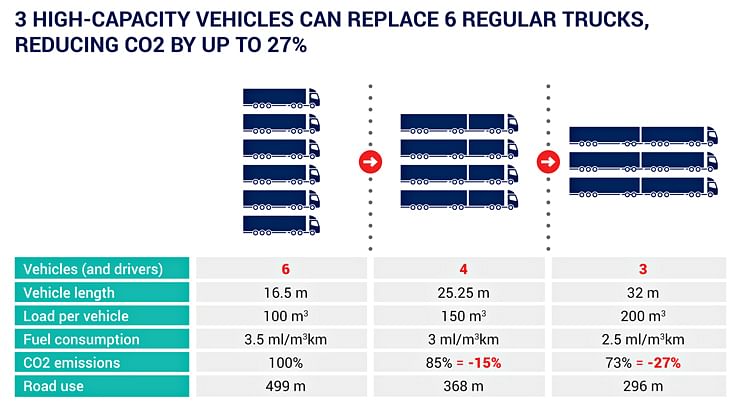Truck makers urge introduction of high-capacity vehicles to slash CO2 emissions in EU
New ACEA study says three high-capacity vehicles can replace six regular trucks, reducing CO2 emissions by up to 27 percent.
As part of wider efforts to reduce CO2 emissions from road transport, the European Automobile Manufacturers’ Association (ACEA) is calling for a policy framework that supports an EU-wide high-capacity transport system. This should allow for high-capacity vehicles – specifically designed to carry twice as much freight as standard trucks – to travel on dedicated parts of the EU road network. ACEA made this call to policy makers at an event in Brussels today.

Experience shows that high-capacity vehicles are more efficient and productive than regular heavy-goods vehicles, as they can consolidate freight from smaller trucks, consuming less fuel and producing less emissions. This makes them more environmentally-friendly than standard vehicle combinations. Indeed, according to a new ACEA paper, three high-capacity vehicles can replace six regular trucks, reducing CO2 emissions by up to 27%.
The EU’s first-ever CO2 standards for heavy-duty vehicles were recently fixed for the years 2025 and 2030. “Truck manufacturers are committed to doing their part to bring down emissions,” explained ACEA Secretary General, Erik Jonnaert. “However, these efficiency standards for new vehicles will not be enough to bring down total CO2 emissions from road transport.”
Demand for freight transport is expected to grow substantially over the next decades. High-capacity vehicles provide a cost-effective means of coping with this growing demand while keeping carbon emissions in check – without having to modify or extend Europe’s existing road infrastructure.
Jonnaert said, “In order to allow the benefits of high-capacity vehicles to be felt right across the entire EU, we urge policy makers to enable the introduction of a high-capacity transport system across borders.” ACEA also calls for harmonised requirements for such vehicles.
High-capacity vehicles in the form of European Modular System (EMS) combinations are already allowed in Belgium, Denmark, Finland, most German federal states, the Netherlands, Portugal, Spain and Sweden. In these countries CO2 reductions have been confirmed in practice. Earlier concerns with respect to a possible modal shift from rail to road, wear and tear of roads and bridges, and safety have also shown to be unjustified.
RELATED ARTICLES
Horse Powertrain reveals hybrid conversion for electric cars
Engine-making joint venture of Geely and the Renault Group announces new hybrid powertrain that fits into the same space...
Aisin to produce hybrid motor for Mitsubishi in Thailand
The hybrid drive motor and gearbox, will be produced at Aisin Powertrain (Thailand) Co for use in the Mitsubishi XForce ...
GM reports strong Q1 sales in China, demand for EVs and hybrids surges 53%
General Motors and its joint ventures in China have sold more than 442,000 units between January and March 2025.






 By Autocar Professional Bureau
By Autocar Professional Bureau
 07 May 2019
07 May 2019
 4945 Views
4945 Views









